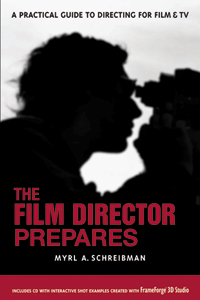(Lone Eagle, 256 pages, $21.95)
By Myrl A. Screibman
 In our increasingly media-saturated world, with images and stories coming at us from every direction and in every medium, creatively oriented young people of every ilk now believe they have it in them to become great film directors. They can’t all be right, however. It’s hard to know what percentage of film school graduates end up working in movies and television, but it’s doubtful the figure even hits 20 percent. Many of those who ended up in other careers might have saved time and money if, before making such a commitment, they’d read Myrl A. Schreibman’s The Film Director Prepares.
In our increasingly media-saturated world, with images and stories coming at us from every direction and in every medium, creatively oriented young people of every ilk now believe they have it in them to become great film directors. They can’t all be right, however. It’s hard to know what percentage of film school graduates end up working in movies and television, but it’s doubtful the figure even hits 20 percent. Many of those who ended up in other careers might have saved time and money if, before making such a commitment, they’d read Myrl A. Schreibman’s The Film Director Prepares.
Schreibman, an adjunct professor at UCLA and author of the Indie Producers Handbook, conveys not merely the range of responsibilities a director must assume, but also the number of different people he or she must be: an astute businessperson and financial planner; a project manager; a creative artist alert to the needs of writers, cinematographers and editors; an astute psychologist (especially in dealing with actors); and a person combining improvisatory flexibility and an iron-fisted sense of discipline. The job of directing, his book tells us - with many examples culled from his own stage, screen and TV experiences - takes more than a pair of jodhpurs, a bullhorn and an ego.
As his Stanislavski-derived title suggests, the most important aspect of film direction is preparation, the myriad tasks and obligations that must preoccupy a director before a millimeter of celluloid is exposed or a single role cast. And he’s not just talking about storyboards. He means a total immersion in the dramatic needs and tonal nuances of the script, an understanding of logistical and budgetary demands, and a sense of how the finished product should look.
In one of his most intriguing chapters, Schreibman shows us the essential fragility and precariousness of the relationship between the director and his actors, exploring issues of trust and empathy. If the key process of casting has gone well, the main problem, he says, is maintaining the tenuous emotional links between actor and role and between actor and director - and no one else, he wisely adds - even when no cameras are running.
Schreibman’s well-paced, comprehensive survey doesn’t just address itself to the neophyte; it should also prove useful to seasoned directors wishing to reacquaint themselves with basic methods and evergreen tenets of the trade. He even has some practical advice about feeding the crew: they “get more done before lunch than after.” Overall, this book presents an essential outline of what is needed to get an unbelievably complex and demanding job done.
Review written by John Patterson.